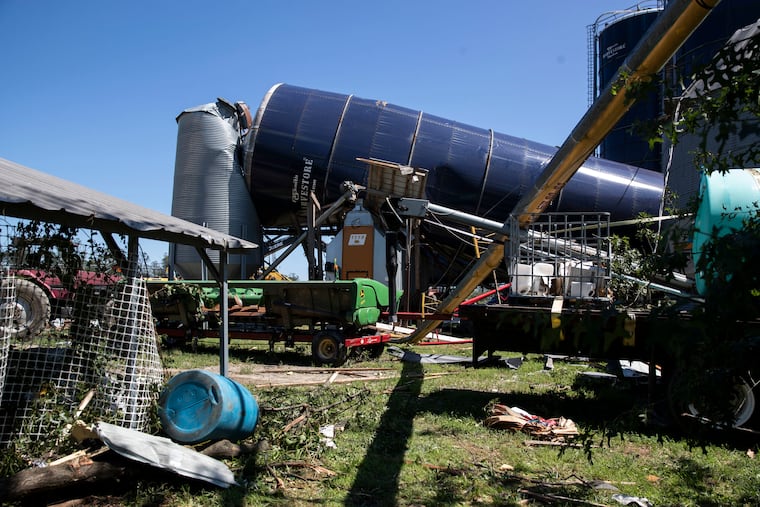N.J.’s largest dairy farmer begs Gov. Murphy: ‘Help us’
New Jersey's largest dairy and vegetable farms in Gloucester County suffered millions of dollars in damages.

The Eachus family’s dairy cows no longer have a barn for shelter.
And the third-generation owners of New Jersey’s largest dairy, called Wellacrest Farms in Mullica Hill, couldn’t store the milk at one point from their 1,400 cow herd — their refrigerated tanks were too damaged.
And the Eachuses expect “millions of dollars” in financial costs from Hurricane Ida. The storm generated an EF-3 tornado that tore through the state’s largest dairy operation, destroying equipment and buildings and trapping hundreds of cows under collapsed barns. Thirteen have died, a couple dozen more suffered injuries. A crew was milking when the twister ripped through and had only seconds to hide and hold on. They saw several cows swallowed by the funnel. About 10 cows remain missing.
The family did manage to repair their milk storage tanks. So they’re milking, storing, and shipping out each morning. But they still face a heap of bills. And Eric Eachus, 29, and grandson of the founder, had one request of Gov. Phil Murphy: “Help us.”
“We haven’t gotten any help from anyone, the state or the federal government,” although U.S. Rep. Jeff Van Drew (R., N.J.) had visited in the past week, Eachus said.
On Wednesday, the governor responded by announcing that FEMA had approved a major disaster declaration for six counties, including Gloucester. That means individuals there can register at www.disasterassistance.gov for direct assistance for Ida-related recovery.
Not that all their losses will be covered.
A neighbor started a $1 million GoFundMe campaign for Wellacrest Farms, and Eric’s mother, Marianne, is now in charge of the fund-raising effort, which has topped $84,000. Another of the county’s largest vegetable producers, the Grasso Farm in Mullica Hill, also was destroyed and its GoFundMe page also has reached $84,000.
The Eachus family said they are encountering pushback from their insurance company, Farm Family, over the extent of damages covered by their policy, which charges $20,000-a-month premiums.
“They’re disputing the value, saying it’s worth half” of their estimate on the farm, Eric Eachus said, “so we’re already hitting roadblocks to full recovery. If we don’t get help, we might have to sell the herd.” A representative from the insurer was not immediately available.
Wellacrest sales average about 17 million pounds of milk annually, and account for roughly 75% of the farm’s total revenues. In addition, they sell horse hay and straw and other custom farming supplies. Wellacrest employs 15 full-time workers and a few part time in addition to the family.
Agriculture experts in South Jersey say the Eachus and the Grasso family farms suffered some of the worst damage from the remnants of Hurricane Ida.
Michelle Infante-Casella works for Rutgers University as an Agricultural Agent and professor with Rutgers Cooperative Extension in the Department of Agriculture and Natural Resources. She estimates that 82% of the state’s agriculture production comes out of South Jersey.
Farming is still big business in New Jersey, ranked seventh in the U.S. for agriculture sales at slightly more than half a billion dollars per year. The most recent Census of Horticulture noted considerable growth compared to the 2014 horticulture census, which ranked New Jersey at $356 million in sales. New Jersey individual and family farms accounted for $106 million of those sales and ranked fourth nationally.
‘The hits keep coming’
When Ida’s winds and tornado hit Mullica Hill on Sept 1, nearly all of the Wellacrest Farms’ barns, silos, and buildings were hit, some collapsing on the cows.
“We got most of them out, but we lost at least 10 from the herd,” Eachus said. Some had to be put down because the animals were so badly injured.
The night after the storm, the Eachus family’s electrician worked from 11 p.m. until 5 a.m. the following morning to restore the generator to power the milking parlor and turn on the water well.
“Since then we’re moving debris. Our barns were destroyed. We have a few walls from the barns and carried them out in front of the farm to create makeshift gates all the way around” the property, and keep the herd enclosed.
The farm’s 100-foot-high silos storing feed blew over and those remaining “are unsafe for use. The hits keep coming,” Eric Eachus said.
Wellacrest is a third generation farm, started by Eachus’s grandfather in 1943. “We want our kids to take over — hopefully — and keep the family business going.”
For the moment, though, they need cow barns — at least two — for wintertime shelter.
Angelo and Leonard Grasso, who are vegetable farmers, “lost just about everything from the Hurricane Ida tornado. Both their homes were damaged and now uninhabitable,” Infante-Casella said.
They are currently living with family members. Farm buildings, greenhouses, trucks, and other equipment were destroyed. Vegetable crops survived in many of their fields down the road, but their equipment and buildings to harvest and pack the crops are gone, she added.
“They are unable to continue farming on their own this season,” said Infante-Casella. “This family just put their life savings into construction of a new packing and cooling facility that meets modern food safety standards. It was completed just last week. In a blink of an eye, that improvement project was destroyed.”
Still unknown is the cost of replacing and rebuilding. New Jersey farms were already struggling against an influx of cheaper imports of vegetables and fruit from Mexico and South America.
Farmers must wait for insurance adjusters to evaluate what’s covered.
“FEMA also just set up at the library in Mullica Hill so people can put in applications for cost recovery from property damage,” said Infante-Casella. “They’re seeing what the adjusters have said. Now they wait to see what’s covered. That’s the big question right now.”
This Associated Press contributed to this article.